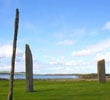 As part of Book Week Scotland, the Scottish Book Trust has been distributing free copies of a short volume called My Favourite Place. It’s a collection of brief stories, poems and songs by members of the public and a handful of familiar names such as Liz Lochhead, Aonghas Pàdraig Caimbeul and Michael Palin.
As part of Book Week Scotland, the Scottish Book Trust has been distributing free copies of a short volume called My Favourite Place. It’s a collection of brief stories, poems and songs by members of the public and a handful of familiar names such as Liz Lochhead, Aonghas Pàdraig Caimbeul and Michael Palin.
Those of us who claim to be place makers should read it. Only a handful of urban locations are mentioned. Most of the entries relate to landscapes, journeys and remote locations. Others recall rooms or a childhood home.
The most obvious theme is the bond between place and people. Many of the stories are really about relationships, turning points or self-discovery. A place is a favourite because of the added substance arising from the personal event or moment in time which occurred there.
It’s a reminder that buildings, streets and spaces don’t become places until you mix them with people. Crucially, they don’t become memorable or valued places unless they are able to celebrate the needs and aspirations of those who use them – and that means much more than basic functions like a driveway for the car or everything crammed under one supermarket roof.
There are no lowest common denominators in My Favourite Place – other than those where people transcended the gloom or mundanity of their physical surroundings. Equally, there are no signs of anything our planning, urban design or architecture has delivered in the last 50 years.
The book reminds us that people know very well what is important to them. It’s a message I’ve heard endlessly this year, as the call for change gathers momentum. People want to recapture the human aspect of place in their communities and they can’t understand why it’s so difficult to be heard. Call it localism or place making, authenticity or the Big Society – its really about identity and voice versus alienation and powerlessness.
There seems to be a willingness to reflect this mood through planning, architecture and place and community empowerment channels at Scottish Government level and a number of local authorities are wrestling with their development plans in an effort to locate settlement or community planning more centrally. Let hope we see some bold policy, plans and subsequent development proposals arising from this.
Meantime, community development trusts and BIDs are beginning to act as a conduit for change, including trusts which are emerging successfully in the aftermath of our recent projects at Haddington, Tomintoul and Glenlivet.
Big politics only seems more detached than ever from the views of the electorate. We do need to re-engage and seek a more responsive approach to government for the people. There’s no doubt that change is needed.
Sustainable economic growth is a fine premise, but is it delivering sustainability in the ‘green’ sense, or the economic sense? Supporting long lasting indigenous growth in our towns seems to be undervalued. And what good is a town centres review if it doesn’t stem from a deeper understanding of the kind of communities we want to foster?
My favourite place? It’s no particular place. It’s a notion of every place being someplace. When you get there, there’s some there, there. It’s a place with a sense of direction, a sense of where it came from and where it’s going. It’s a place we’d all want to live in, all want to visit, all want to emulate. Can it exist? I’m sure the authors of My Favourite Place would all say ‘Yes’.
“Disneyland is the only people trap operated by a mouse.” – Author Unknown
Richard Heggie
